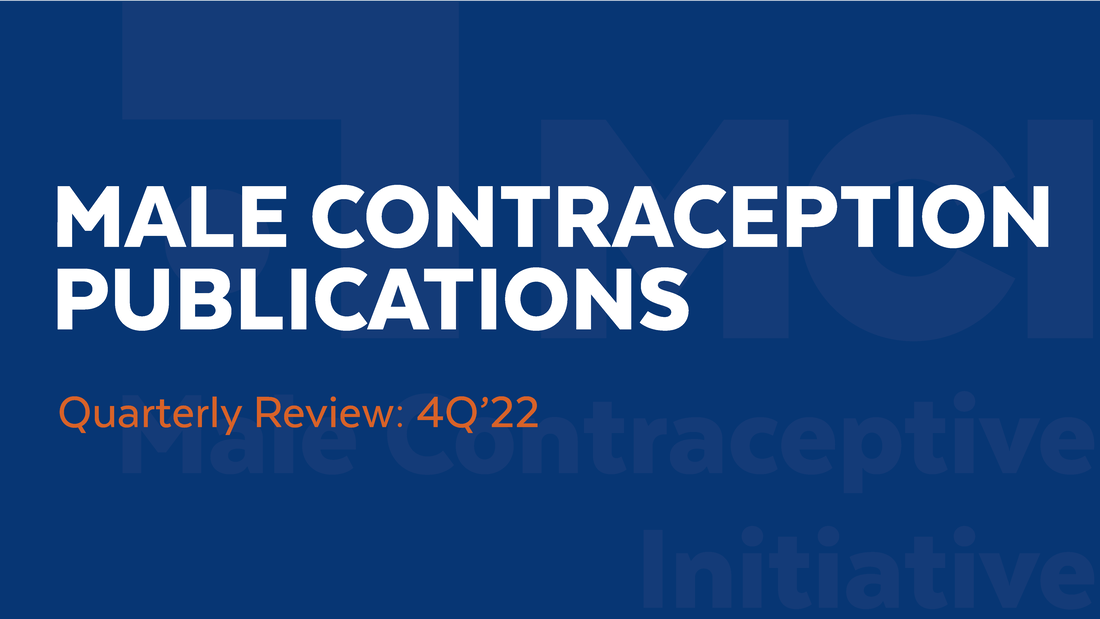|
This blog series highlights pertinent publications that were featured in MCI's monthly newsletter editions in the fourth quarter of 2022. The purpose of this blog is to report interesting or relevant work from MCI Fellows, Grantees, staff members, and other community authors in the field of male contraception. In humans, the prototypical second messenger cyclic AMP is produced by 10 adenylyl cyclase isoforms, which are divided into two classes. Nine isoforms are G protein coupled transmembrane adenylyl cyclases (tmACs; ADCY1-9) and the 10th is the bicarbonate regulated soluble adenylyl cyclase (sAC; ADCY10). Co-authored by MCI Grantees Drs. Lonny Levin and Jochen Buck, this review details why sAC is uniquely druggable and outlines ways to target sAC for novel forms of male and female contraception. In the wake of the recent Roe vs. Wade judgment, a team of researchers performed a Google Trends analysis to identify the impact of this decision on the interests regarding contraceptive choices in the United States. A Google Trends search between April 6 and July 5, 2022, with the United States as the area of interest, was performed using the five most popular contraception choices. Additionally, a second trend search was performed using oral and injectable hormonal birth control measures. The results indicated that trends showed a spike in interest regarding various contraceptive methods immediately following the verdict. The highest increase in interest was noted for "vasectomy," followed by "tubal ligation." With respect to oral and injectable birth control measures, "morning after pill" showed a marked spike in interest. The team concluded that this verdict triggered increased interest in contraceptive practices, which can be translated into better reproductive health with proper public health initiatives. This paper shares more details about their study and findings. The diterpenoid triepoxides triptolide and triptonide from Tripterygium wilfordii (thunder god wine) exhibit unique bioactivities with potential uses in disease treatment and as a non-hormonal male contraceptives. In this study, researchers show that cytochrome P450s (CYPs) from the CYP71BE subfamily catalyze an unprecedented 18(4→3) methyl shift required for biosynthesis of the abeo-abietane core structure present in diterpenoid triepoxides and in several other plant diterpenoids. In combination with two CYPs of the CYP82D subfamily, four CYPs from T. wilfordii are shown to constitute the minimal set of biosynthetic genes that enables triptonide biosynthesis using Nicotiana benthamiana and Saccharomyces cerevisiae as heterologous hosts. In addition, co-expression of a specific T. wilfordii cytochrome b5 (Twcytb5-A) increases triptonide output more than 9-fold in S. cerevisiae and affords isolation and structure elucidation by NMR spectroscopic analyses of 18 diterpenoids, providing insights into the biosynthesis of diterpenoid triepoxides. These findings pave the way for diterpenoid triepoxide production via fermentation. The importance of phosphorylation in sperm during spermatogenesis has not been pursued extensively. Testis-specific serine kinase 3 (Tssk3) is a conserved gene, but TSSK3 kinase functions and phosphorylation substrates of TSSK3 are not known. The goals of these studies were to understand the mechanism of action of TSSK3. To do so, the research team analyzed the localization of TSSK3 in sperm, used CRISPR/Cas9 to generate TSSK3 knockout (KO) mice in which nearly all of the TSSK3 open reading frame was deleted (ensuring it is a null mutation), analyzed the fertility of TSSK3 KO mice by breeding mice for 4 months, and conducted phosphoproteomics analysis of male testicular germ cells. Through their work, the research team, including MCI Grantee Dr. Thomas Garcia, demonstrated that TSSK3 is essential for male fertility and crucial for phosphorylation of multiple infertility-related proteins. These studies and the pathways in which TSSK3 functions have implications for human male infertility and non-hormonal contraception. Forty percent of US pregnancies are unintended despite currently available contraceptives. A substantial number of men use the currently available methods of male contraception (i.e., condoms and vasectomy) and a large majority would be interested in novel forms of male contraception if available. Research into male contraception has been ongoing for more than 50 years, with hormonal contraceptives nearing clinical utility and non-hormonal methods hopefully becoming available, albeit with a longer time frame. However, uncertainty regarding benchmarks for the efficacy and safety of male contraception continue to be an issue with development and regulatory approval. In addition, pharmaceutical industry support is minimal with the NIH and Foundations being the main research funders. This paper by luminaries Drs. Stephanie Page and John Amory asserts that, given the continuing high rates of unintended pregnancy, many of which are now occurring in areas with extremely restricted access to legal abortion, additional focus and investment in male contraceptive development is imperative. Are there any interesting publications about non-hormonal, reversible male contraception that you'd like to see featured? Please reach out to us and share your thoughts!
0 Comments
Your comment will be posted after it is approved.
Leave a Reply. |
Categories
All
Archives
June 2024
|
|
|
Donate to Male Contraceptive InitiativeYour generous donation makes a difference!
|
© Male Contraceptive Initiative. All rights reserved.



 RSS Feed
RSS Feed
